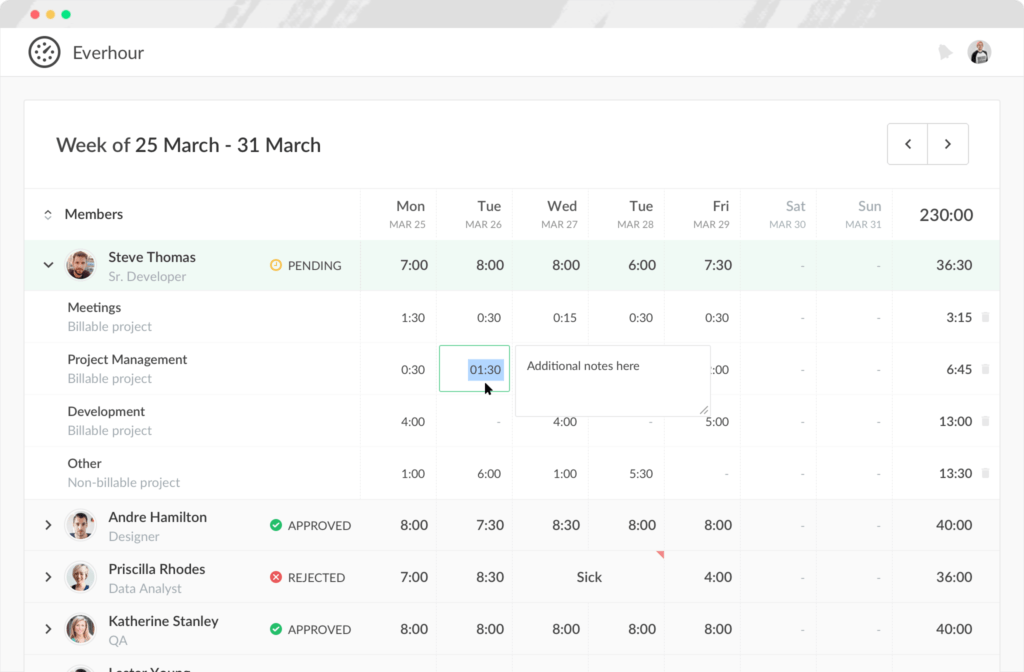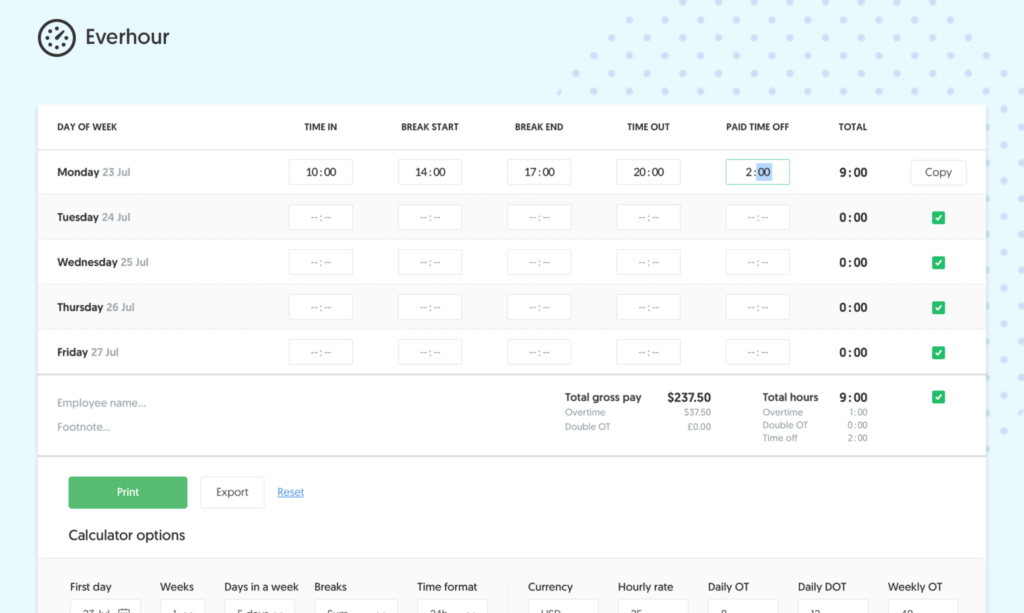Ever wondered what is the definition of takt time vs. cycle time vs. lead time? These metrics collaboratively enable you to observe and assess the effectiveness of your team’s time allocation for a specific project or task, determining its positive impact on your business.
But improving internal times isn’t the only bottom line. It boosts customer satisfaction too, which can lead to higher profits – up to 60% in fact!
In this article, we’ll demystify the terms and show you exactly how to calculate them so that you can improve your company’s productivity and potentially increase profits (and make sure to check out the best time tracking software out there to help with that)
Understanding Cycle Time: Formula and Practical Example
In a nutshell, calculating cycle time gives you an overall idea of how long it really takes to get work done.
Cycle time is the time it takes to complete one production cycle from beginning to end.
For example, if you work in a software development environment, this may mean the time from the beginning of coding to the release of the software. You can measure the cycle time of your end-to-end development process or a subset of the process that’s important to you.
If you work in a traditional production environment, this could mean how long it takes to produce an item, such as one cup, one bed, one door, etc.
Why is this important? Having an idea of how your cycle time compares to other metrics, you can make sure you’ll be able to meet demand and minimize the risk of losing clients. If your takt time shows your company’s demand is high (more on that below) but your cycle time is low, it’s a signal that you will need to take steps to raise it in order to meet demand.
Process cycle time formula & real-life example
Using this simple cycle time formula, you can calculate how long it takes to complete one production cycle:
Cycle Time (CT) = Net Production Time (NPT) / Units Produced (UP)
Let’s say you operate a creative agency, and your client requires 3 new pieces of video content completed next month. Say your team worked 264 hours to create 3 videos. Here’s how that would look using cycle time:
CT (88h) = NPT (264h) / UP (3 videos)
This means it took your team 88 hours per video. Let’s move on and see how this compares to your takt time.
Takt Time Explained: How to Meet Client Demand Efficiently
Now that we have cycle time under wraps, it’s time to look at the takt time definition. The takt time is calculated by how fast and efficiently you or your company needs to work to meet the requirements of your client or project.
Essentially, the takt time calculation is the basis for matching supply and demand within your company.
Takt time can be said to be “high” or “low” as the term itself “takt” is a German word meaning pulse. That means, if client or project demand is high, takt should also be high; if demand is low, takt may be low.
- Why do you need to measure takt? Firstly, measuring this time within your project allows you to adjust production/output to meet needs without running into overproduction, wasting resources, or underproduction, not having enough to fulfill an order.
- What if my product isn’t physical? Takt isn’t tied to physical products. Even if you’re not working with something material, failing to take account of takt means you could be overworking your employees. This leads to burnout, lowers morale by having them do monkey jobs, and even wastes your own resources or staff that you don’t necessarily require.
-
What benefits can I get by measuring takt? Because takt sets the optimal pulse at which your company operates, there are numerous benefits you can observe, such as:
- Ensuring production matches demand
- Ability to provide your clients with more accurate delivery estimates
- Knowing how many staff and resources you need at any time
- Better able to predict downtime and opportunities for training
- More accurate financial management
Takt time formula & real-life example
Using this simple takt time formula, you can evaluate the rate your company needs to work to productively fulfill client demand:
Takt Time = Available Work Time / Client Demand
- To get your Available Work Time, you can use Everhour to evaluate how much time your team spends productively working towards an activity in any given period.
- Then just divide that by Client Demand – the overall work that needs to be done within a similar time period.
Sounds complicated? Here’s what it could look like in real life:
Let’s go back to that creative agency. Your client requires 3 new pieces of video content completed next month. You have 2 employees dedicated to this project whose productivity time (minus breaks, etc.) is 30 hours per week. Using the formula, we get:
TT (80) = AWT (240) / CD (3)
This means that for every 80 hours of work, you need to create 1 video. Since your cycle time equals 88 hours, your team isn’t keeping up with demand.
You should do something about it. For example, try to optimize – use different software, pre-made templates, or faster scriptwriting technique – or assign more staff.
Lead Time Overview: How to Optimize Your Delivery Process
We’ve covered takt time and cycle time, now let’s move on and look at the definition of lead time:
Lead time is the time it takes for one unit or one sale to make it from the order being received to its final payment.
When a client enters your business looking for a sale quote, your estimate to them will consider your lead time in order to give them a result in an acceptable waiting time.
Lead time formula & real-life example
To evaluate the time your company needs to deliver the order once it’s been placed, use the following formula:
Lead Time (LT) = Preprocessing time + Cycle time + Inspection time
Back to the example of operating a creative agency, if it took your team 2 days to process a client’s initial request and confirm it, 88 hours (~4 days) to create a video they asked for, and then it took your client one week to review the video to see if it meets their specifications, your lead time was 13 days:
LT (13d) = PT (2d) + CT (4d) + IT (7d)
Why is lead time important? Lead time helps define how long it takes from getting an order to final sale. If your lead time is high – aka exceeds your cycle time by a lot – you’re left with a lot of unused products in your company or time wasted by your employees. Alternatively, if your lead time is not higher than cycle time (i.e. if your preprocessing, cycle, and inspection times overlap), this means you’re not meeting demand or not providing good customer service, and your customers are unlikely to be satisfied.
Lead time real-life example
Let’s say a client enters your business looking for a bulk order of shoes – 10,000 pairs to put in its retail stores in October for the Christmas season.
It takes 1 week to get all the parts and 2 weeks to assemble 10,000 units, so your company has a lead time of about one month. That means that you must get the order from the client no later than September 1 in order to make the delivery on time.
Lead Time vs Cycle Time vs Takt Time
Now that we’ve got the calculations out of the way, you’re probably wondering, what is the difference between these three-time metrics? And, even more importantly, how do they work together?
- What’s the difference – takt time vs. cycle time? While both are essential when it comes to productivity, these two metrics focus on different aspects. Takt accounts for the rate that needs to be achieved to meet demand, while Cycle focuses on the measurement of work done.
- What’s the difference – lead time vs. cycle time? The main difference between these two metrics is the amount of time they take into account. Lead time accounts for the entire order receiving, production, and sales process, whereas Cycle time focuses on production time alone.
- What’s the difference – lead time vs. takt time? While lead time is the total time between receiving an order and delivering an item, takt time focuses on the maximum time your team should spend between starting to work on the item and delivering that item.
In a nutshell, cycle time is internally focused, looking at how long you actually need to produce an item. In turn, takt time focuses on what needs to be achieved in terms of production time to keep up with the demand. Finally, lead time examines your clients’ waiting times (how long it takes you to deliver the order once they have placed it).
Individually they are each extremely helpful in helping you to get to know your business a little better from the inside out. But when combined, they show a fuller picture of how efficiently your company is operating.
- If your takt time is high, in order to meet demand, you’ll need to increase your cycle time.
- By knowing your lead time, you can predict how long processing an order takes for your clients – aka wait time.
- All this together indicates how satisfied your customers are likely to be.
By keeping all these times in check, you can improve the efficiency of your business and boost client satisfaction.
For an even deeper dive into the topic of these three metrics and when they apply, check out this video:
How can Everhour help you?
Everhour is an easily integrated time tracking solution to help you manage your time and business more efficiently.
When you need to calculate your cycle, lead, or takt time, you can do so via Everhour’s software or using our integrations with popular project management tracking tools – Asana, Trello, Basecamp, Jira, GitHub to name a few – that lets you monitor working time and productiveness effectively.
Depending on your type of business, you may choose to use:
Online timesheet software

The best timesheet software for small businesses is perfect if you want to monitor your working time or if you’re looking to upgrade and optimize your current processes, saving time and money.
Free time card calculator

This lets you manually calculate how much time your employees spent actually working.
If you are managing a team of 5 or more and looking to boost efficiency, Everhour is the perfect tool to keep your team on track. With seamless time tracking, one of the best digital time clocks for employees, you can easily estimate task durations, set clear budgets, and generate detailed reports inside Asana, Trello, Jira, or any other pm tool.
Any questions left?
Get in touch with us at ask@everhour.com. We will be happy to consult you on how Everhour can help you boost productivity in your company.

